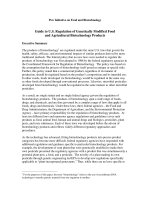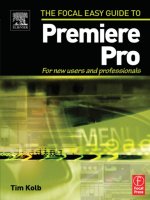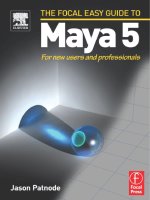the focal easy guide to adobe audition 2.0 for new users and professionals
Bạn đang xem bản rút gọn của tài liệu. Xem và tải ngay bản đầy đủ của tài liệu tại đây (4.78 MB, 149 trang )
THE FOCAL EASY GUIDE TO
ADOBE
®
AUDITION
™
2.0
Prelims-K52018.qxd 5/20/06 11:23 AM Page i
The Focal Easy Guide Series
Focal Easy Guides are the best choice to get you started with new software,
whatever your level. Refreshingly simple, they do
not
attempt to cover
everything, focusing solely on the essentials needed to get immediate results.
Ideal if you need to learn a new software package quickly, the Focal Easy Guides
offer an effective, time-saving introduction to the key tools, not hundreds of pages
of confusing reference material. The emphasis is on quickly getting to grips with
the software in a practical and accessible way to achieve professional results.
Highly illustrated in color, explanations are short and to the point. Written by
professionals in a user-friendly style, the guides assume some computer knowledge
and an understanding of the general concepts in the area covered, ensuring they
aren’t patronizing!
Series editor: Rick Young (www.digitalproduction.net)
Director and Founding Member of the UK Final Cut User Group, Apple Solutions
Expert and freelance television director/editor, Rick has worked for the BBC, Sky,
ITN, CNBC and Reuters. Also a Final Cut Pro Consultant and author of the
best-selling
The Easy Guide to Final Cut Pro
.
Titles in the series:
The Easy Guide to Final Cut Pro 3,
Rick Young
The Focal Easy Guide to Final Cut Pro 4,
Rick Young
The Focal Easy Guide to Final Cut Express,
Rick Young
The Focal Easy Guide to Maya 5,
Jason Patnode
The Focal Easy Guide to Discreet combustion 3,
Gary M. Davis
The Focal Easy Guide to Premiere Pro,
Tim Kolb
The Focal Easy Guide to Flash MX 2004,
Birgitta Hosea
The Focal Easy Guide to DVD Studio Pro 2,
Rick Young
The Focal Easy Guide to Discreet Combustion 3,
Gary M. Davis
Prelims-K52018.qxd 5/20/06 11:23 AM Page ii
THE FOCAL EASY GUIDE TO
ADOBE
®
AUDITION
™
2.0
ANTONY BROWN
AMSTERDAM
•
BOSTON
•
HEIDELBERG
•
LONDON
•
NEW YORK
•
OXFORD
PARIS
•
SAN DIEGO
•
SAN FRANCISCO
•
SINGAPORE
•
SYDNEY
•
TOKYO
Focal Press is an imprint of Elsevier
Prelims-K52018.qxd 5/20/06 11:23 AM Page iii
Focal Press is an imprint of Elsevier
Linacre House, Jordan Hill, Oxford OX2 8DP, UK
30 Corporate Drive, Suite 400, Burlington MA 01803, USA
First edition 2006
Copyright © 2006, Antony Brown. Published by Elsevier Ltd. All rights reserved.
The right of Antony Brown to be identified as the author of this work has been
asserted in accordance with the Copyright, Designs and Patents Act 1988
No part of this publication may be reproduced, stored in a retrieval system or
transmitted in any form or by any means electronic, mechanical, photocopying,
recording or otherwise without the prior written permission of the publisher
Permission may be sought directly from Elsevier’s Science & Technology Rights
Department in Oxford, UK: phone (ϩ44) (0) 1865 843830; fax (ϩ44) (0) 1865 853333;
email: Alternatively you can submit your request online by
visiting the Elsevier web site at and
selecting
Obtaining permission to use Elsevier material
Notice
No responsibility is assumed by the publisher for any injury and/or damage to persons
or property as a matter of products liability, negligence or otherwise, or from any use or
operation of any methods, products, instructions or ideas contained in the material herein.
Because of rapid advances in the medical sciences, in particular, independent verification
of diagnoses and drug dosages should be made
British Library Cataloguing in Publication Data
A catalogue record for this book is available from the British Library
Library of Congress Cataloging-in-Publication Data
A catalog record for this book is available from the Library of Congress
ISBN-13: 978-0-24-052018-6
ISBN-10: 0-24-052018-1
Typeset by Charon Tec Ltd, Chennai, India
www.charontec.com
Printed and bound in the Canada
For information on all Architectural Press publications visit
our website at www.books.elsevier.com
Prelims-K52018.qxd 5/20/06 11:23 AM Page iv
Contents
Acknowledgements ix
Preface xi
1 Setup 1
Loading Adobe Audition 2.0 2
Project Setup 3
Setting Up the Device Hardware 4
Latency 5
Preferences/key Commands 6
New features in Adobe Audition 2.0 6
2 The Interface 9
Introduction to the Audition 2.0 Interface 10
Multitrack View 10
The Edit View 11
CD View 12
Video panel 13
Files Panel 14
Effects Panel 14
Favourites Panel 15
Tools Palette 16
Transport/Time Format/Zoom Window/Session Properties 16
Audio Mixer Panel 16
Mastering Rack 17
Spectral Views 18
Workspaces 19
3 Importing, Recording, Playback 21
Importing Files 22
Importing Audio Files in Audition 2.0 22
v
Prelims-K52018.qxd 5/20/06 11:23 AM Page v
Import/Extract Audio from CD 23
Import Video Files 24
Import Audio only from Video Files 24
Auditioning Files 25
Recording Audio into Audition 2.0 25
Monitoring 26
Setting the Input Level 26
Consumer Soundcard Input Level Adjustment 26
Professional ASIO Driver Soundcard Input Level Adjustment 27
Setting the Monitoring Mode and Level 28
To Record Audio into the Edit View 29
To Record Audio into the Multitrack View 30
Punch In 31
4 Editing (Edit View) 33
Introduction 34
Editing 35
Zooming and Navigating 37
Using the Range Tool 39
Editing Functions Overview 40
Using Effects in Edit View 45
Adding XMP Metadata to Audio Clips 54
5 Multitrack View 57
Introduction 58
Working with Sessions 58
Importing Files into the Multitrack View 61
Snapping 62
Editing Procedures Overview 62
Trimming 63
Adjusting Volumes, Panning 66
Adding Real-time FX from Multitrack View 67
Setting the EQ 68
vi
CONTENTS
Prelims-K52018.qxd 5/20/06 11:23 AM Page vi
Track Automation Lanes 69
Automating Parameters/Automation Lanes 70
Automating Parameters/Clip Envelopes 71
Types of crossfades curves 73
Using the Mixer 73
The Channel Strip 74
Effects 75
Level Control 77
6 Looping Content 79
Introduction to Looping 80
Working with Loops 81
Find Beats and Mark (Edit View) 82
Define a Loop 83
Calculate and Adjust Tempo 83
Tempo Matching Settings 84
Using the Included Loopology Content 84
7 Restoration Tools 87
Overview 88
Removing Noise Procedure 89
Noise Reduction plug-in overview 91
Click/Pop Eliminator 92
Repair Transients 94
Using the Repair Transients Tool 94
Lasso Tool 95
Removing specific sounds with in Special View 96
Marquee Tool 97
Removing Vocal from Existing Mixes 98
8 Surround Sound 101
Surround Sound Overview 102
The Surround Encoder 102
Placing Tracks in the Surround Field 103
Planning Tracks in the Surround Field 103
vii
CONTENTS
Prelims-K52018.qxd 5/20/06 11:23 AM Page vii
Previewing 104
Multi-channel Exporting 105
9 Working with Video 107
Importing Video Files 108
Video Thumbnail Display Options 108
Time Stretching Audio To Fit Video 109
Export Video 110
Integration with Other Adobe Products 111
10 Mastering, Finalising 113
Overview of the Mastering Process 114
Dynamic Processing (Compression/Limiting) 114
Multiband Compressor 114
Parametric Equalizer 116
Equalizer settings 117
Hard Limiter Overview 119
11 Exporting, Saving Files/Projects 121
Export Audio (Multitrack View) 122
Audio File Formats (mp3, wav) 124
Export Audio (Edit View) 124
Batch Processing 125
12 Making a CD 127
CD Project View 128
To Change the Order of Files 129
Group Waveform Normalize 129
Burning a CD 130
Index 131
viii
CONTENTS
Prelims-K52018.qxd 5/20/06 11:23 AM Page viii
Acknowledgements
I would like to thank the team at Focal Press, especially Catharine Steers for all
her support and patience throughout this journey. Also, I wish to acknowledge
Kevan O’Brien at Adobe; my wife, Zoë who has been a great source of
encouragement to me; and my family: Jeffery, Sylvie and Kylie.
ix
Prelims-K52018.qxd 5/20/06 11:23 AM Page ix
This page intentionally left blank
Preface
My first introduction to Adobe Audition was when a friend showed me how the
software could remove a precise section of sound from within an audio file
without affecting the surrounding areas. Since that time, I have used Audition on
many feature films for cleaning up dialogues, removing dog barks, bird chatter,
camera noises and many other sounds that no other software currently available
can accomplish. Audition 2.0 is also a very efficient audio editing application to
use when time is limited; it can breeze through many complex editing tasks in a
short space of time.
The goal of this book is to get you up-to-speed as quickly as possible using
all the tools that Adobe Audition 2.0 has to offer. Throughout this book there
are diagrams accompanying the text to ensure that you understand all the
procedures. Whether you are a complete novice or have a background in sound
this book is for you. If you are using the Adobe Production Studio, which
includes Premier Pro 2.0, After Effects 7, Encore 2.0; then getting familiar with
Audition 2.0 will reinvent the way you work with audio within the Production
Studio Collection. The integration between the Production Studio product lines
makes the use of Audition easier than ever before.
Adobe Audition 2.0 is Adobe’s main professional quality audio editing software
application. It has a number of great functions including advanced restoration
tools; fast editing functionality; a mastering rack with studio quality effects plug-
ins; over 5000 loopology music content files to create complex music beds; low
latency mixing engine with ASIO soundcard support throughout; and surround
sound mixing capabilities. Video files can be imported into the Audition 2.0
timeline, and sound effects can be spotted with frame accuracy using both the
thumbnail and main video monitor view. Audio files can be burnt directly to CD,
and your files will be automatically converted to the correct format for this. You are
also able to group normalise files to make sure all CD tracks are the same level.
I hope you enjoy reading this easy guide and that it will increase your
knowledge and give you new skills for working with Adobe Audition 2.0.
Antony Brown
xi
Prelims-K52018.qxd 5/20/06 11:23 AM Page xi
This page intentionally left blank
CHAPTER 1
SET UP
Ch01-K52018.qxd 5/20/06 11:13 AM Page 1
Loading Adobe Audition 2.0
2
THE FOCAL EASY GUIDE TO ADOBE
®
AUDITION
™
2.0
Installing Adobe Audition 2.0 on Windows XP is a straightforward procedure:
simply insert the CD and follow the prompts. You will be prompted to associate
file types that will enable your computer to launch Audition to play them
instead of another application, such as Windows Media Player. If there is
Ch01-K52018.qxd 5/20/06 11:13 AM Page 2
3
SET UP
Note: If you have the Adobe Production Studio Premium edition software, which
includes Audition 2.0, Premier Pro 2, After FX 7, Encore 2, Photoshop CS2 and
Illustrator CS2, the one serial number supplied will load the whole collection. Or you
can select individual components of the production studio collection (Audition
2.0 ϩ Functional content) to load on your system.
any specific file types you don’t want Audition to open, then deselect them;
otherwise press OK.
File association on loading the software
Project Setup
Adobe Audition 2.0 will prompt you to set temporary folders on your drive to
use. As Audition is dealing heavily with audio, it is best to use a separate drive
if available for overall efficiency. When ready, go ahead and press OK and
Audition 2 will open.
Ch01-K52018.qxd 5/20/06 11:13 AM Page 3
4
THE FOCAL EASY GUIDE TO ADOBE
®
AUDITION
™
2.0
Note: The ‘Release ASIO Driver in Background’ button releases the soundcard from
Audition 2.0, so that other ASIO programs can use the soundcard device to play
audio while Audition is open in the background. Highlighting Audition will
re-allocate the soundcard back to Audition for playback – as long as the other
application releases its ASIO driver too.
Setting Up the Device Hardware
Audition 2.0 now supports ASIO compatible sound cards for optimised low
latency performance and audio scrubbing. It also works with any Windows-
compatible soundcard, although latency performance will be reduced. Inputs
and outputs for Edit View, Multitrack and Surround Encoder View are set from
this window. Depending on the physical layout of your soundcard, different
input and output port configurations can be set for each of the three main
views within Audition.
To set up your audio hardware within Adobe Audition 2.0:
1
ChooseϾEditϾAudio Hardware Set up
2
Select the Edit View tab
3
Select appropriate ASIO soundcard from the Audio Drive drop
down menu
4
Set the input and output ports
5
Repeat process for Multi-track and Surround Encoder Views.
Ch01-K52018.qxd 5/20/06 11:13 AM Page 4
Latency
Latency in basic terms means the time it takes for sound to travel in and out
of your computer via the soundcard. The standard Buffer Size setting of most
onboard computer audio soundcards is around 2048, samples which result in a
lag or delay in playback. An example of this would be talking into a microphone
plugged into your computer soundcard and hearing a delay when monitoring
5
SET UP
Latency: time it takes for sound to pass from Microphone –
Computer soundcard – Speakers
Ch01-K52018.qxd 5/20/06 11:13 AM Page 5
the output; this is known as latency. Using Audition with an ASIO driver
supported soundcard will allow you to directly monitor your input signal while
recording with very low latency, sometimes known as ‘zero latency’.
Preferences/key Commands
Preferences
Under the EditϾPreferences tab you have a number of options to fine-tune the
way you use Audition 2.0, including:
● Display and colour scheme
● Memory use
● The amount of times you can use ‘undo’
● Auto save – timed amount to save your project
● External controllers – assigning external mixer controllers i.e. Mackie Control
● Temporary audio folders – setting the Hard Drive space available.
Keyboard Shortcuts
The keyboard shortcut settings are another method for customising the way
you work. If you are new to Audition but have knowledge of other software
programs, keyboard shortcuts can be set-up within Audition to work as you like.
To access keyboard shortcuts choose EDITϾKey commands.
New features in Adobe Audition 2.0
● ASIO driver support
● Direct to file recording
● Low-latency mixing engine
6
THE FOCAL EASY GUIDE TO ADOBE
®
AUDITION
™
2.0
Ch01-K52018.qxd 5/20/06 11:13 AM Page 6
● Recordable parameter automation
● Hardware controller automation
● Audio mixing sends and inserts
● Real-time input monitoring
● Quick Punch
● Automatic delay compensation
● Effects chain on all channels, buses, and master
● Improved recording performance
● Unlimited tracks in Multi-track View
● Up to 96 live inputs and outputs
● Complete customizable workspaces
● Broader video format support
● Tighter integration with Adobe Premiere Pro and After Effects
● Improved user interface
● Custom workspaces
● Uncompressed 32-bit music loops
● Ready-to-use music beds
● Direct Adobe Bridge accessibility (note: the Bridge is
not
a part of
Audition)
● XMP metadata support
● Audible scrubbing
● Analog-modeled multiband compressor
● Mastering rack in Edit View
● Enhanced frequency space editing
7
SET UP
Ch01-K52018.qxd 5/20/06 11:13 AM Page 7
● Lasso tool
● New Spectral Controls, Spectral Pan and Phase display
● Save CD layouts
● Enhanced Broadcast wave support
● Improved performance for editing
● Ogg Vorbis format support
8
THE FOCAL EASY GUIDE TO ADOBE
®
AUDITION
™
2.0
Ch01-K52018.qxd 5/20/06 11:13 AM Page 8
CHAPTER 2
THE INTERFACE
Ch02-K52018.qxd 5/20/06 11:14 AM Page 9
Introduction to the Audition 2.0 Interface
On launching Audition 2.0 you will be met with a brand new graphical interface,
including new workspace panels that can be customised along with a revamped
Mixer and Effects Mastering Rack.
Audition is made up of three main workspace areas: Multitrack View, Edit View
and CD View, each view having its own panel layout and purpose. Each
workspace is made up of separate panels that can be resized, docked or grouped
to other panels within the workspace. Panels can also be floated separately.
In this chapter we will firstly look at an overview of all the different panels and
interfaces and what each is used for.
1. Multitrack View
10
THE FOCAL EASY GUIDE TO ADOBE
®
AUDITION
™
2.0
The Multitrack enables you to record, edit and arrange multi-
ple mono and stereo audio files into a musical session. The
Ch02-K52018.qxd 5/20/06 11:14 AM Page 10
Multitrack View is made up of separate panels that can be resized and docked to
other panels, customising your workflow. The Main panel is where multiple audio
clips can be arranged along a timeline. A video clip can be imported, allowing
you to accurately synchronise sound effects and music to the picture. There are
controls to adjust volume, panning, add real-time effects and mix, all from within
the Multitrack View.
Main Panel
Within the Multitrack View you have the Main panel showing audio and
video tracks vertically, with video thumbnail preview and audio clips
displayed horizontally across the panel. At the bottom of the panel the
horizontal ruler or timeline shows hours, minutes and seconds. Different
formats such as SMPTE time code and samples can be displayed by right
clicking on the horizontal rulerϾdisplay time format and selecting the
desired mode.
Main Tab
On the left side of the Main panel window there are four
tabs showing overall settings for input/output, effects,
sends and EQ within your Multitrack project.
11
THE INTERFACE
2. Edit View
The Edit View is Audition’s main workspace for editing and mastering
single mono and stereo audio files. Editing functions such as cut,
paste, trim, normalise and mastering can all be done from within this
view. Zooming functions allow you to select specific ranges of audio down
to sample level for precise editing. The Edit View has additional spectral
frequency displays that allow you to see and edit the audio in a Photoshop
style way.
Ch02-K52018.qxd 5/20/06 11:14 AM Page 11
3. CD View
12
THE FOCAL EASY GUIDE TO ADOBE
®
AUDITION
™
2.0
Edit View Main Panel
Ch02-K52018.qxd 5/20/06 11:14 AM Page 12









